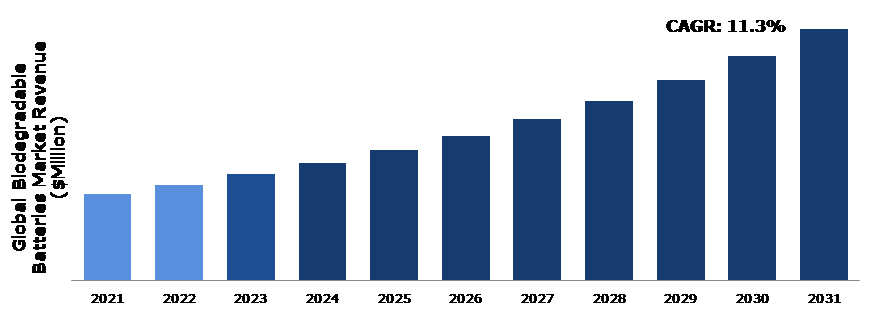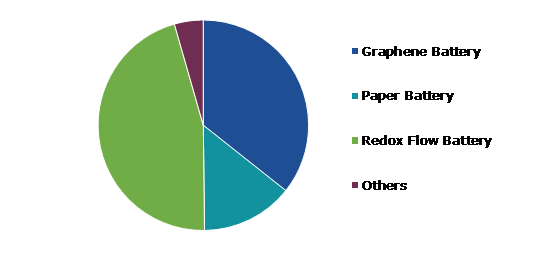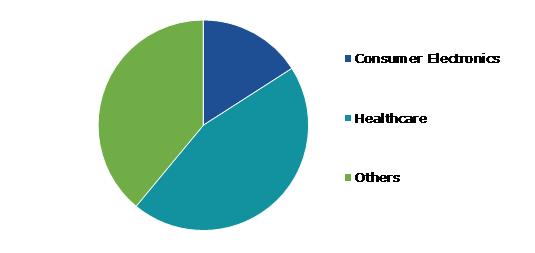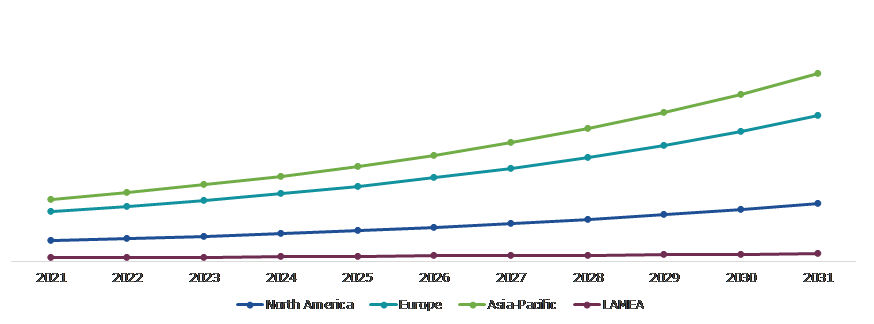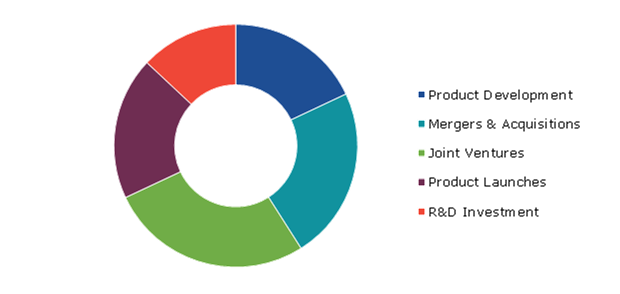Biodegradable Batteries Market Report
RA08665
Biodegradable Batteries Market by Battery Type (Graphene Battery, Paper Battery, Redox Flow Battery, and Others), Application (Consumer Electronics, Healthcare, and Others), and Regional Analysis (North America, Europe, Asia-Pacific, and LAMEA): Global Opportunity Analysis and Industry Forecast, 2022–2031
Global Biodegradable Batteries Market Analysis
The Global Biodegradable Batteries Market Size was $140.0 million in 2021 and is predicted to grow with a CAGR of 11.3%, by generating a revenue of $406.7 million by 2031.
Global Biodegradable Batteries Market Synopsis
Biodegradable batteries are gaining popularity owing to the increase in demand for eco-friendly and sustainable technologies. These batteries are made from biodegradable materials such as cellulose, paper, and algae, which are renewable resources and can be easily broken down by microorganisms without harming the environment. A trend towards greener alternatives has been brought on by rising environmental awareness regarding the effects of conventional batteries. In addition, the demand for biodegradable batteries is growing due to the requirement for sustainable energy sources to power consumer electronics. All these factors are contributing to the rise in demand for biodegradable batteries.
The high cost of investment in R&D activities is expected to hinder the overall biodegradable batteries market growth during the forecast period. In addition, less awareness about biodegradable batteries in developing countries is likely to limit the biodegradable batteries market expansion. These are the major factors predicted to hamper the market revenue growth in the upcoming years.
Biodegradable batteries present an opportunity in the field of energy storage due to their potential to address both environmental concerns and the need for sustainable energy storage. These batteries can offer a long-term sustainable solution for energy storage in several applications, including electric vehicles, portable electronics, and renewable energy systems. These batteries' production and disposal have a lesser effect on the environment as the biodegradable materials which are used in them are sourced from renewable resources. In addition, biodegradable batteries' post-lifecycle decomposition can benefit soil health and carbon sequestration, minimizing their negative environmental effects.
According to regional analysis, the Asia-pacific biodegradable batteries market accounted for the highest market share in 2021 and is projected to maintain its dominance during the forecast period. Biodegradable battery research in Asia-Pacific has been on the rise due to several factors such as the increase in demand for energy storage solutions, the emergence of new technologies, and strong government support for R&D.
Biodegradable Batteries Market Overview
A biodegradable battery is a type of battery that can naturally break down and biodegrade after use without harming the environment. Biodegradable materials such as cellulose, paper, and algae are used to make the batteries. Biodegradable batteries are an eco-friendly alternative to traditional batteries, as traditional batteries often contain harmful and non-biodegradable materials that can damage the environment when not appropriately disposed.
COVID-19 Impact on Biodegradable Batteries Market
There has been a mixed impact of the COVID-19 pandemic on the biodegradable battery market. The outbreak has caused an unprecedented slowdown in the global economy, affecting the demand for various products and services, including biodegradable batteries. The pandemic had a severe impact on numerous sectors including the automobile and electronics sectors, which has negatively impacted the growth prospects of biodegradable batteries. However, the pandemic also raised awareness among the consumers regarding the need for environmentally friendly and sustainable technologies, which is expected to increase the demand for biodegradable batteries in the upcoming years. The pandemic has resulted in an increase in interest in green technologies and solutions by highlighting the value of environmental sustainability. In addition, there has been an increase in government funding for green technology R&D, including the development of biodegradable batteries. This support has augmented innovation and development in the biodegradable batteries market, which is anticipated to drive the market growth in the post-pandemic period.
Rising Research Regarding the Use of Biodegradable Batteries in the Healthcare Sector to Drive the Market Growth
There are several research ongoing regarding the use of biodegradable batteries in healthcare owing to their potential for eco-friendly and safe implantable medical devices. Pacemakers, defibrillators, and medication delivery systems are just a few examples of the implantable medical devices that frequently need long-lasting, portable power sources that are also safe and dependable. When conventional batteries are disposed of inappropriately, they can be hazardous and constitute a danger of environmental pollution when used in implantable medical devices. Biodegradable batteries, on the other hand, are created from natural ingredients and can safely degrade inside the body once they have completed powering the device. Therefore, increase in research regarding the use of these batteries in the healthcare sector are anticipated to drive the market growth in the upcoming years.
Less Awareness About Biodegradable Batteries in the Developing Countries is Anticipated to Restrain the Market Growth
Comparatively to conventional batteries, people are still less aware about biodegradable batteries. The main reason for this is that biodegradable battery is still a relatively new technology and has not yet gained widespread market acceptance. The dominance of conventional batteries in several industries, including the automobile and electronics sectors, is another factor expected to hamper the biodegradable batteries market expansion. These industries have long used conventional batteries and are more familiar with their characteristics and functionality. All these are key factors predicted to hinder the biodegradable batteries market growth during the forecast period.
Rising Demand for Sustainable and Eco-friendly Energy Storage Solutions is Anticipated to Offer Lucrative Growth Opportunities
Biodegradable batteries provide a viable option for conventional batteries, which are frequently manufactured from non-renewable and non-biodegradable materials. Portable gadgets, electric cars, and renewable energy systems could all benefit from the usage of biodegradable batteries. In addition, they serve as a safe and dependable power supply for medical devices including pacemakers and drug delivery systems. Also, initiatives are being taken to encourage the use of biodegradable batteries and increase knowledge of their advantages. For instance, several businesses are advertising the eco-friendliness, safety, and durability of their biodegradable battery products. Therefore, the biodegradable batteries market presents an opportunity for companies and researchers to develop sustainable and eco-friendly energy storage solutions in the future.
Global Biodegradable Batteries Market, by Battery Type
Based on battery type, the market is further divided into graphene battery, paper battery, redox flow battery, and others. Among these, the redox flow battery sub-segment accounted for the largest market share in 2021.
Global Biodegradable Batteries Market Size, by Battery Type, 2021
The redox flow battery sub-segment accounted for the largest market share in 2021. The development of redox flow biodegradable batteries is a potential area for the creation of sustainable energy storage systems. Redox flow batteries that are environmentally friendly and biodegradable are currently being developed. These batteries are generally made of organic molecules and plant-based polymers, which are natural materials that can decompose safely in the environment. Redox flow biodegradable batteries have the potential to be used in a wide range of applications, including electric cars and the storage of renewable energy. In comparison to conventional batteries, they have a number of benefits, including as a longer lifespan, quicker recharge times, and better energy densities.
Global Biodegradable Batteries Market, by Application
Based on application, the global biodegradable batteries market has been divided into consumer electronics, healthcare, and others. Among these, the healthcare sub-segment accounted for the largest market share in 2021 and the consumer electronics sub-segment is anticipated to show a fastest CAGR during the forecast period.
Global Biodegradable Batteries Market Share, by Application, 2021
The healthcare sub-segment accounted for the largest market share in 2021. There are numerous benefits of biodegradable batteries in healthcare applications. Biodegradable batteries can be used safely in the body or implanted without endangering the patient as biocompatible materials are used to make them. Biodegradable batteries reduce the danger of toxicity in the event of device failure or implantation as they are made of non-toxic materials. Overall, the advantages of biodegradable batteries make them a promising technology for healthcare applications such as pacemakers, drug delivery systems, and biosensors.
The consumer electronics sub-segment is anticipated to show the fastest growth rate during the forecast period. Biodegradable batteries have great potential in consumer electronics as they offer many benefits over traditional batteries. Wearable electronics like smartwatches and fitness trackers can be powered by biodegradable batteries in the upcoming years. Biodegradable batteries are a secure and appropriate energy storage option as these gadgets are frequently in contact with the skin. Biodegradable batteries are anticipated a practical and sustainable substitute for energy storage in consumer devices.
Global Biodegradable Batteries Market, Regional Insights
The biodegradable batteries market was investigated across North America, Europe, Asia-Pacific, and LAMEA.
Global Biodegradable Batteries Market Size & Forecast, by Region, 2021-2031 (USD Million)
Asia-Pacific Dominated the Biodegradable Batteries Market in 2021
Asia-Pacific dominated the global biodegradable batteries market in 2021. Some of the world's most populated cities are in Asia-Pacific. Environmental issues are also becoming more of a problem in the region. Traditional batteries are now being replaced in this region with biodegradable ones, which are more environmentally responsible and can lessen the negative effects of electronic waste on the environment. The use of renewable and sustainable energy sources is actively promoted by many governments in Asia-Pacific. Governments of various countries in the region are promoting the use of biodegradable batteries through financial incentives and regulatory support because they are seen as a crucial part of this endeavor.
Global Biodegradable Batteries Market Competitive Scenario
Joint ventures, investment, merger & acquisition, product development, and technological development are the common strategies followed by major biodegradable batteries market players. For instance, in 2021, Nexus Power, an India-based startup developed a lithium-free biodegradable battery cell made from proteins that are derived from crop waste.
Some of the leading players in biodegradable batteries market are Nexus Power, Better Battery Co., KEMIWATT, CMBlu Energy AG, Stora Enso, Sony, XL Batteries, and BeFC.
| Aspect | Particulars |
| Historical Market Estimations | 2020 |
| Base Year for Market Estimation | 2021 |
| Forecast timeline for Market Projection | 2022-2031 |
| Geographical Scope | North America, Europe, Asia-Pacific, and LAMEA |
| Segmentation by Battery Type
|
|
| Segmentation by Application |
|
| Key Companies Profiled |
|
Q1. What is the size of the biodegradable batteries market?
A. The global biodegradable batteries market size was over $140.0 million in 2021 and is anticipated to reach $406.7 million by 2031.
Q2. Which are the leading companies in the biodegradable batteries market?
A. Better Battery Co., XL Batteries, and Stora Enso are some of the key players in the global biodegradable batteries market.
Q3. Which region possesses greater investment opportunities in the coming future?
A. Asia-Pacific possesses great investment opportunities for investors in the upcoming years.
Q4. What is the growth rate of the Asia-Pacific market?
A. The Asia-Pacific biodegradable batteries market is anticipated to grow at 11.7% CAGR during the forecast period.
Q5. What are the strategies opted by the leading players in this market?
A. Product innovations, business expansions, and technological advancements are the key strategies opted by the operating companies in this market.
Q6. Which companies are investing more on R&D practices?
A. Sony, BeFC, and Nexus Power investing more on R&D activities for developing new products and technologies.
1.Research Methodology
1.1.Desk Research
1.2.Real time insights and validation
1.3.Forecast model
1.4.Assumptions and forecast parameters
1.5.Market size estimation
1.5.1.Top-down approach
1.5.2.Bottom-up approach
2.Report Scope
2.1.Market definition
2.2.Key objectives of the study
2.3.Report overview
2.4.Market segmentation
2.5.Overview of the impact of COVID-19 on Global Biodegradable Batteries market
3.Executive Summary
4.Market Overview
4.1.Introduction
4.2.Growth impact forces
4.2.1.Drivers
4.2.2.Restraints
4.2.3.Opportunities
4.3.Market value chain analysis
4.3.1.List of raw material suppliers
4.3.2.List of manufacturers
4.3.3.List of distributors
4.4.Innovation & sustainability matrices
4.4.1.Technology matrix
4.4.2.Regulatory matrix
4.5.Porter’s five forces analysis
4.5.1.Bargaining power of suppliers
4.5.2.Bargaining power of consumers
4.5.3.Threat of substitutes
4.5.4.Threat of new entrants
4.5.5.Competitive rivalry intensity
4.6.PESTLE analysis
4.6.1.Political
4.6.2.Economical
4.6.3.Social
4.6.4.Technological
4.6.5.Environmental
4.7.Impact of COVID-19 on Biodegradable Batteries market
4.7.1.Pre-covid market scenario
4.7.2.Post-covid market scenario
5.Biodegradable Batteries Market Analysis, by Battery Type
5.1.Overview
5.2.Graphene Battery
5.2.1.Definition, key trends, growth factors, and opportunities
5.2.2.Market size analysis, by region
5.2.3.Market share analysis, by country
5.3.Paper Battery
5.3.1.Definition, key trends, growth factors, and opportunities
5.3.2.Market size analysis, by region
5.3.3.Market share analysis, by country
5.4.Redox Flow Battery
5.4.1.Definition, key trends, growth factors, and opportunities
5.4.2.Market size analysis, by region
5.4.3.Market share analysis, by country
5.5.Others
5.5.1.Definition, key trends, growth factors, and opportunities
5.5.2.Market size analysis, by region
5.5.3.Market share analysis, by country
5.6.Research Dive Exclusive Insights
5.6.1.Market attractiveness
5.6.2.Competition heatmap
6.Biodegradable Batteries Market Analysis, by Application
6.1.Consumer Electronics
6.1.1.Definition, key trends, growth factors, and opportunities
6.1.2.Market size analysis, by region
6.1.3.Market share analysis, by country
6.2.Healthcare
6.2.1.Definition, key trends, growth factors, and opportunities
6.2.2.Market size analysis, by region
6.2.3.Market share analysis, by country
6.3.Others
6.3.1.Definition, key trends, growth factors, and opportunities
6.3.2.Market size analysis, by region
6.3.3.Market share analysis, by country
6.4.Research Dive Exclusive Insights
6.4.1.Market attractiveness
6.4.2.Competition heatmap
7.Biodegradable Batteries Market, by Region
7.1.North America
7.1.1.U.S.
7.1.1.1.Market size analysis, by Battery Type
7.1.1.2.Market size analysis, by Application
7.1.2.Canada
7.1.2.1.Market size analysis, by Battery Type
7.1.2.2.Market size analysis, by Application
7.1.3.Mexico
7.1.3.1.Market size analysis, by Battery Type
7.1.3.2.Market size analysis, by Application
7.1.4.Research Dive Exclusive Insights
7.1.4.1.Market attractiveness
7.1.4.2.Competition heatmap
7.2.Europe
7.2.1.Germany
7.2.1.1.Market size analysis, by Battery Type
7.2.1.2.Market size analysis, by Application
7.2.2.UK
7.2.2.1.Market size analysis, by Battery Type
7.2.2.2.Market size analysis, by Application
7.2.3.France
7.2.3.1.Market size analysis, by Battery Type
7.2.3.2.Market size analysis, by Application
7.2.4.Spain
7.2.4.1.Market size analysis, by Battery Type
7.2.4.2.Market size analysis, by Application
7.2.5.Rest of Europe
7.2.5.1.Market size analysis, by Battery Type
7.2.5.2.Market size analysis, by Application
7.2.6.Research Dive Exclusive Insights
7.2.6.1.Market attractiveness
7.2.6.2.Competition heatmap
7.3.Asia-Pacific
7.3.1.China
7.3.1.1.Market size analysis, by Battery Type
7.3.1.2.Market size analysis, by Application
7.3.2.Japan
7.3.2.1.Market size analysis, by Battery Type
7.3.2.2.Market size analysis, by Application
7.3.3.India
7.3.3.1.Market size analysis, by Battery Type
7.3.3.2.Market size analysis, by Application
7.3.4.Australia
7.3.4.1.Market size analysis, by Battery Type
7.3.4.2.Market size analysis, by Application
7.3.5.South Korea
7.3.5.1.Market size analysis, by Battery Type
7.3.5.2.Market size analysis, by Application
7.3.6.Rest of Asia-Pacific
7.3.6.1.Market size analysis, by Battery Type
7.3.6.2.Market size analysis, by Application
7.3.7.Research Dive Exclusive Insights
7.3.7.1.Market attractiveness
7.3.7.2.Competition heatmap
7.4.LAMEA
7.4.1.Brazil
7.4.1.1.Market size analysis, by Battery Type
7.4.1.2.Market size analysis, by Application
7.4.2.UAE
7.4.2.1.Market size analysis, by Battery Type
7.4.2.2.Market size analysis, by Application
7.4.3.Rest of LAMEA
7.4.3.1.Market size analysis, by Battery Type
7.4.3.2.Market size analysis, by Application
7.4.4.Research Dive Exclusive Insights
7.4.4.1.Market attractiveness
7.4.4.2.Competition heatmap
8.Competitive Landscape
8.1.Top winning strategies, 2021
8.1.1.By strategy
8.1.2.By year
8.2.Strategic overview
8.3.Market share analysis, 2021
9.Company Profiles
9.1.Nexus Power
9.1.1.Overview
9.1.2.Business segments
9.1.3.Product portfolio
9.1.4.Financial performance
9.1.5.Recent developments
9.1.6.SWOT analysis
9.2.Better Battery Co.
9.2.1.Overview
9.2.2.Business segments
9.2.3.Product portfolio
9.2.4.Financial performance
9.2.5.Recent developments
9.2.6.SWOT analysis
9.3.KEMIWATT
9.3.1.Overview
9.3.2.Business segments
9.3.3.Product portfolio
9.3.4.Financial performance
9.3.5.Recent developments
9.3.6.SWOT analysis
9.4.CMBlu Energy AG
9.4.1.Overview
9.4.2.Business segments
9.4.3.Product portfolio
9.4.4.Financial performance
9.4.5.Recent developments
9.4.6.SWOT analysis
9.5.Stora Enso
9.5.1.Overview
9.5.2.Business segments
9.5.3.Product portfolio
9.5.4.Financial performance
9.5.5.Recent developments
9.5.6.SWOT analysis
9.6.Sony
9.6.1.Overview
9.6.2.Business segments
9.6.3.Product portfolio
9.6.4.Financial performance
9.6.5.Recent developments
9.6.6.SWOT analysis
9.7.XL Batteries
9.7.1.Overview
9.7.2.Business segments
9.7.3.Product portfolio
9.7.4.Financial performance
9.7.5.Recent developments
9.7.6.SWOT analysis
9.8.BeFC
9.8.1.Overview
9.8.2.Business segments
9.8.3.Product portfolio
9.8.4.Financial performance
9.8.5.Recent developments
9.8.6.SWOT analysis
In today’s modern world, where technological innovations are rapidly influencing our lives, batteries have become an essential component of our everyday routines. However, with growing concern for environmental sustainability, it is now critical to address the harmful effects of conventional batteries. This is where biodegradable batteries come into play.
The biodegradable batteries market refers to the industry focusing on the production, development, and marketing of environmentally friendly batteries. A biodegradable battery is one that can naturally break down after usage without damaging the environment. The batteries are made from biodegradable materials such as paper, cellulose, and algae. Conventional batteries frequently contain hazardous and non-biodegradable components that can harm the environment when improperly disposed of, making biodegradable batteries a more environmentally friendly option.
Recent Trends in the Biodegradable Batteries Market
The biodegradable batteries market is continuously evolving with new technology developments and rising environmental concerns. Biodegradable batteries must be compatible with electronic devices and systems. Efforts are being made to achieve smooth integration with existing technology, allowing for the production of entirely biodegradable electronic gadgets. This integration involves investigating novel production techniques and developing battery layouts that can be easily integrated into electronic products. Moreover, one of the most difficult difficulties in biodegradable batteries is attaining equivalent energy density and performance to conventional batteries. The performance of biodegradable battery technologies has undergone significant improvements in terms of power output, capacity, and all-around effectiveness. Researchers are focusing on improving the efficiency of these batteries to make them easier to use for commercial purposes.
Newest Insights in the Biodegradable Batteries Market
As per a report by Research Dive, the global biodegradable batteries market is expected to grow at a CAGR of 11.3% and generate revenue of $406.7 million by 2031. The primary factors driving the growth of the market are the increasing need for eco-friendly and sustainable technology, as well as biodegradable batteries, due to the need for sustainable energy sources to power consumer devices. However, the high cost of investment in R&D activities and lack of awareness about biodegradable batteries in developing nations are expected to hinder the market growth.
The biodegradable batteries market in Asia-Pacific is expected to remain dominant in the coming years. The region's high revenue in 2021 was driven by the emergence of new technologies, a rise in need for energy storage solutions, and strong government support for R&D activities. This has led to an increased demand for innovative and sustainable energy storage solutions in a variety of industries, such as automotive, consumer electronics, and renewable energy.
How are Market Players Responding to the Rising Demand for Biodegradable Batteries?
Market players are responding to the rising demand for biodegradable batteries by investing in research and development to create more eco-friendly and sustainable battery solutions. They are also exploring new materials and methods to lessen the environmental impact of existing batteries.
In addition, market players are increasingly focusing on strategic partnerships and collaborations with other players in the industry to leverage their strengths and expand their reach. Some of the foremost players in the biodegradable batteries market are Better Battery Co., Nexus Power, KEMIWATT, Stora Enso, CMBlu Energy AG, Sony, BeFC, XL Batteries, and others. These players are focused on implementing strategies such as mergers and acquisitions, novel developments, collaborations, and partnerships to reach a leading position in the global market.
For instance,
- In December 2020, ‘Nexus Power’," co-founded by Bhubaneswar-based Nikita Baliarsingh and Nishita Baliarsingh in 2019, used crop waste to create bio-organic, quick-charging EV batteries.
- In May 2021, Exide Technologies, a foremost supplier of stored electrical energy products, updated its Exide Premium product range by launching a new modern black design with new recyclable components with an aim to reduce environmental impact.
COVID-19 Impact on the Biodegradable Batteries Market
The COVID-19 pandemic had a moderate impact on the global biodegradable batteries market. The outbreak has brought about an uncommon worldwide economic slowdown, which made an impact on the demand for a variety of products and services, like biodegradable batteries. The pandemic had a significant negative effect on a number of industries, including the automotive and electronics industries, which has harmed the growth prospects of biodegradable batteries. However, the pandemic has increased curiosity about green solutions and innovations by highlighting the need for environmental sustainability. Moreover, the pandemic also increased consumer awareness of the necessity for ecologically friendly and sustainable technologies, which is anticipated to boost the demand for biodegradable batteries in the coming years. These factors had a significant impact on the biodegradable batteries market growth during the pandemic.
Personalize this research
- Triangulate with your own data
- Request your format and definition
- Get a deeper dive on a specific application, geography, customer or competitor
- + 1-888-961-4454 Toll - Free
- support@researchdive.com

